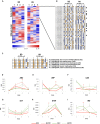Transcriptional Responses to Pre-flowering Leaf Defoliation in Grapevine Berry from Different Growing Sites, Years, and Genotypes
- PMID: 28512461
- PMCID: PMC5411443
- DOI: 10.3389/fpls.2017.00630
Transcriptional Responses to Pre-flowering Leaf Defoliation in Grapevine Berry from Different Growing Sites, Years, and Genotypes
Abstract
Leaf removal is a grapevine canopy management technique widely used to modify the source-sink balance and/or microclimate around berry clusters to optimize fruit composition. In general, the removal of basal leaves before flowering reduces fruit set, hence achieving looser clusters, and improves grape composition since yield is generally curtailed more than proportionally to leaf area itself. Albeit responses to this practice seem quite consistent, overall vine performance is affected by genotype, environmental conditions, and severity of treatment. The physiological responses of grape varieties to defoliation practices have been widely investigated, and just recently a whole genome transcriptomic approach was exploited showing an extensive transcriptome rearrangement in berries defoliated before flowering. Nevertheless, the extent to which these transcriptomic reactions could be manifested by different genotypes and growing environments is entirely unexplored. To highlight general responses to defoliation vs. different locations, we analyzed the transcriptome of cv. Sangiovese berries sampled at four development stages from pre-flowering defoliated vines in two different geographical areas of Italy. We obtained and validated five markers of the early defoliation treatment in Sangiovese, an ATP-binding cassette transporter, an auxin response factor, a cinnamyl alcohol dehydrogenase, a flavonoid 3-O-glucosyltransferase and an indole-3-acetate beta-glucosyltransferase. Candidate molecular markers were also obtained in another three grapevine genotypes (Nero d'Avola, Ortrugo, and Ciliegiolo), subjected to the same level of selective pre-flowering defoliation (PFD) over two consecutive years in their different areas of cultivation. The flavonol synthase was identified as a marker in the pre-veraison phase, the jasmonate methyltransferase during the transition phase and the abscisic acid receptor PYL4 in the ripening phase. The characterization of transcriptome changes in Sangiovese berry after PFD highlights, on one hand, the stronger effect of environment than treatment on the whole berry transcriptome rearrangement during development and, on the other, expands existing knowledge of the main molecular and biochemical modifications occurring in defoliated vines. Moreover, the identification of candidate genes associated with PFD in different genotypes and environments provides new insights into the applicability and repeatability of this crop practice, as well as its possible agricultural and qualitative outcomes across genetic and environmental variability.
Keywords: berry transcriptome; flavonoid; grapevine; pre-flowering defoliation; secondary metabolite.
Figures

 ” = Pre-flowering defoliation.
” = Pre-flowering defoliation.




Similar articles
-
Selective defoliation affects plant growth, fruit transcriptional ripening program and flavonoid metabolism in grapevine.BMC Plant Biol. 2013 Feb 22;13:30. doi: 10.1186/1471-2229-13-30. BMC Plant Biol. 2013. PMID: 23433030 Free PMC article.
-
Source-Sink manipulations have major implications for grapevine berry and wine flavonoids and aromas that go beyond the changes in berry sugar accumulation.Food Res Int. 2023 Jul;169:112826. doi: 10.1016/j.foodres.2023.112826. Epub 2023 Apr 17. Food Res Int. 2023. PMID: 37254402
-
Same Season and Carry-Over Effects of Source-Sink Adjustments on Grapevine Yields and Non-structural Carbohydrates.Front Plant Sci. 2021 Jul 26;12:695319. doi: 10.3389/fpls.2021.695319. eCollection 2021. Front Plant Sci. 2021. PMID: 34381481 Free PMC article.
-
Omics Approaches for Understanding Grapevine Berry Development: Regulatory Networks Associated with Endogenous Processes and Environmental Responses.Front Plant Sci. 2017 Sep 7;8:1486. doi: 10.3389/fpls.2017.01486. eCollection 2017. Front Plant Sci. 2017. PMID: 28936215 Free PMC article. Review.
-
Secondary metabolites in grapevine: crosstalk of transcriptional, metabolic and hormonal signals controlling stress defence responses in berries and vegetative organs.Front Plant Sci. 2023 Jun 19;14:1124298. doi: 10.3389/fpls.2023.1124298. eCollection 2023. Front Plant Sci. 2023. PMID: 37404528 Free PMC article. Review.
Cited by
-
Comparative transcriptome analyses between cultivated and wild grapes reveal conservation of expressed genes but extensive rewiring of co-expression networks.Plant Mol Biol. 2021 May;106(1-2):1-20. doi: 10.1007/s11103-021-01122-2. Epub 2021 Feb 4. Plant Mol Biol. 2021. PMID: 33538951
-
Sunburn in Grapes: A Review.Front Plant Sci. 2021 Jan 8;11:604691. doi: 10.3389/fpls.2020.604691. eCollection 2020. Front Plant Sci. 2021. PMID: 33488654 Free PMC article. Review.
-
The impact of genetic similarity and environment on the flavonoids variation pattern of Cyclocarya paliurus.Sci Rep. 2024 Oct 15;14(1):24187. doi: 10.1038/s41598-024-74957-6. Sci Rep. 2024. PMID: 39406858 Free PMC article.
-
Secondary Metabolites Coordinately Protect Grapes from Excessive Light and Sunburn Damage during Development.Biomolecules. 2021 Dec 28;12(1):42. doi: 10.3390/biom12010042. Biomolecules. 2021. PMID: 35053190 Free PMC article.
-
Comparative physiological, metabolomic, and transcriptomic analyses reveal developmental stage-dependent effects of cluster bagging on phenolic metabolism in Cabernet Sauvignon grape berries.BMC Plant Biol. 2019 Dec 26;19(1):583. doi: 10.1186/s12870-019-2186-z. BMC Plant Biol. 2019. PMID: 31878879 Free PMC article.
References
-
- Agudelo-Romero P., Erban A., Sousa L., Pais M. S., Kopka J., Fortes A. M. (2013). Search for transcriptional and metabolic markers of grape pre-ripening and ripening and insights into specific aroma development in three Portuguese cultivars. PLoS ONE 8:e60422 10.1371/journal.pone.0060422 - DOI - PMC - PubMed
-
- Alagna V., Barbagallo M. G., Di Lorenzo R., Scafidi P., Pisciotta A. (2014). Effetti di differenti intensità ed epoche di defogliazione sui parametri vegeto-produttivi e sulla qualità dell’uva della cv Nero d’Avola. Acta Italus Hortus 13 168–169.
-
- Baggiolini M. (1952). Les stades repère dans le développement annuel de la vigne et leur utilization pratique. Rev. Rom. Agric. Vitic. Arb. 8 4–6.
LinkOut - more resources
Full Text Sources
Other Literature Sources
Molecular Biology Databases

